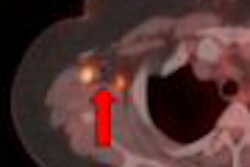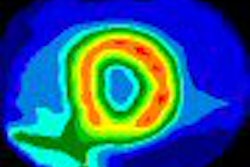F-18 FDG-PET can effectively distinguish benign spinal lesions from malignant ones, according to a study presented at the 2008 American Academy of Orthopaedic Surgeons (AAOS) meeting in San Francisco.
In the study, 53 patients with sarcomas and biopsy-proven spinal or paraspinal tumors underwent F-18 FDG-PET imaging. This imaging method proved to be a precise method for distinguishing benign from malignant lesions, according to study author Dr. Joshua Patt, an orthopedic surgeon at the Carolinas Medical Center in Charlotte, NC.
"With FDG-PET, we have an improved ability to recognize the extent of disease. However, there is an increased burden of interpretation and increased incidences of incidental findings," Patt said. MRI is an excellent tool for studying spinal tumors, but FDG-PET has not been studied in spinal tumors. However, it has proved useful in diagnosing brain and lung cancers and lymphomas, he noted.
"With this study, we wanted to understand the ability of PET imaging to improve patient care and eliminate unnecessary interventions," Patt said.
In the prospective study, 17 patients had paraspinal involvement of their tumors and 36 had spinal involvement. Maximum standardized uptake values (SUVmax) were obtained for all lesions as a quantitative measurement of metabolic activity.
The results showed that 38 patients had malignant lesions and 15 had benign lesions. An analysis of FDG uptake revealed a mean SUVmax for benign lesions of 3.3 (standard deviation [SD] 1.9) and 8.6 (SD 11) for malignant lesions. SUVmax was most sensitive when comparing benign and high-grade lesions, according to Patt. In regression analysis that adjusted for gender location and lesion size, the factors most significantly predictive of SUVmax were age and tumor grade.
Patt noted that the study findings revealed that FDG-PET can successfully discriminate benign from malignant spinal lesions, and can thus be an aid in diagnosing these lesions. "The role of PET in staging and management of suspicious lesions merits further investigation," he said.
While FDG-PET is widely used in oncology, its utility for spinal lesions has not yet been well established, Patt said. However, with U.S. Centers for Medicare and Medicaid Services (CMS) expanded reimbursement in 2005, the door to expanded use of FDG-PET has been opened wider. "Eventually, we might even be able to use PET not only in diagnosis of spinal tumors, but also to assess which are treatment-responsive," he said.
By Barbara Boughton
AuntMinnie.com contributing writer
April 9, 2008
Related Reading
Radiosurgery eases pain of spinal tumors, March 19, 2008
New progress in multiple myeloma treatment; MDCT has edge in detection, June 18, 2007
Copyright © 2008 AuntMinnie.com




















